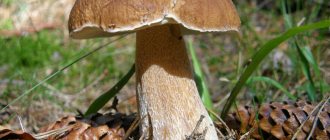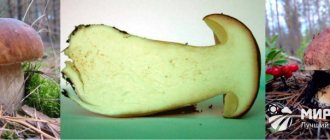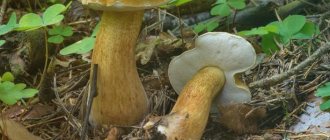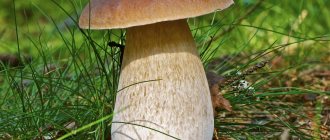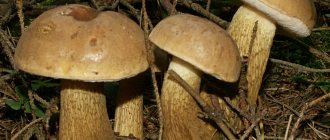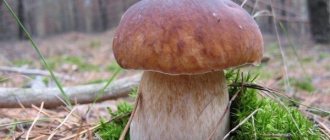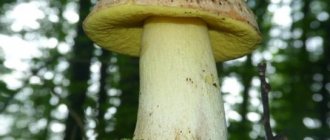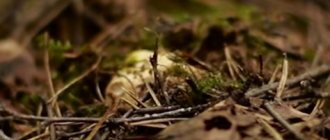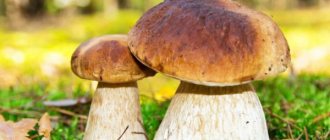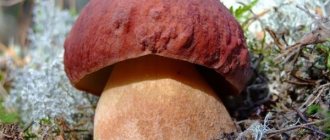The porcini mushroom (lat. Boletus edulis) represents the most respected mushroom genus - boletus. If earlier he was called the “king of mushrooms,” today we can say about him that he is the undisputed leader of the mushroom rating. This hero has unparalleled taste. It is difficult to confuse the porcini mushroom with its doubles and inedible analogues - it is so beautiful and unique. Boletus is the most desired trophy of a mushroom picker.
Appearance
Porcini mushrooms are characterized by their large size, massive caps of a pleasant brown hue, and light roundish legs. There are real record holders among them.
Large white mushroom
Interesting fact : records for the size of mushrooms have been repeatedly recorded. In 1961, a mushroom weighing over 10 kg with a cap of 58 cm was found. In 1964, the second largest boletus was recorded, which weighed almost 7 kg.
Contraindications
Whatever the useful product and whatever gastronomic qualities it has, before use you should always take into account not only the beneficial properties of white boletus and the contraindications that it has. It is recommended to use the mushroom with caution in case of diseases:
- stomach,
- liver and gallbladder,
- kidney,
- intestines.
And in the acute stage, it is better to completely exclude dishes with white aspen from the diet. In any case, it would be a good idea to have a preliminary consultation with a doctor you trust.
In addition, white boletus is contraindicated:
- having an allergy to mushrooms,
- pregnancy,
- lactation period.
If you are prone to allergic reactions, you need to be careful and include white boletus in your diet gradually, starting with a small amount. Individual intolerance is also possible.
Since mushrooms are a rather difficult product for the digestive system, they are not recommended for children under 7 years of age.
Literature:
T.A. Ilyina. Mushrooms. Atlas-determinant.
A.P. Umeltsev. Encyclopedia of mushroom picker.
Lagutina T.V. The complete encyclopedia of mushrooms.
Description
Mushrooms belong to the Borovik genus. Their characteristic feature is a distinct aroma and light, pleasant taste. The mushroom cap can be different shades of brown. Its size in diameter varies between 7-30 cm. If conditions are favorable, mushrooms can grow up to half a meter in diameter of the cap.
Its appearance allows you to find out the age of the mushroom. Young boletus mushrooms are distinguished by their beautiful, smooth, curved cap. And in older people it becomes almost flat and rough. With age, its shade darkens.
The top layer of the cap, which is usually removed before further processing of the mushroom, fits tightly to the pulp. This makes it difficult to separate the skin. Wind and lack of moisture negatively affect the condition of the fungus. Cracks appear on the surface, due to which it quickly deteriorates. Rainy weather contributes to the formation of a thin mucus layer.
White mushrooms
The flesh of young specimens is white and dense. It is characterized by juiciness and a subtle aroma. Old boletus mushrooms are yellowish in color. When mechanically damaged, the pulp hardly changes in color.
The height of the leg is about 12 cm, and the diameter is 7 cm. Under favorable conditions, large specimens up to 25 cm in height are found. Ripe mushrooms have barrel-shaped legs. In old boletus, it can change shape - it becomes cylindrical. The shade of the legs is from white to brown.
White mushroom in section
The boletus has a veil. But you can see it only at the growth stage - it is a shell that protects the body. In mature specimens, the base of the stem becomes perfectly clean.
The spore powder has a rich dark green color. The spores acquire a spindle-shaped shape and are characterized by miniature sizes.
Similar species and false look-alikes
During a “silent hunt”, the ability to recognize each individual type of mushroom and distinguish it from similar edible species is of great importance. But the most important thing is to learn to distinguish it from inedible and poisonous mushrooms that are similar in appearance, which can harm not only health, but sometimes even human life.
How to distinguish pine porcini mushroom
Although this species has quite remarkable external characteristics, there are nevertheless quite a lot of similar species with which it can be confused when collected. First of all, these are the closest related species of the pine porcini mushroom - a variety of porcini mushroom (Boletus edulis).
Since these mushrooms are edible and have high taste, it will not be a problem if, when collecting a pine porcini mushroom, birch, spruce or oak porcini mushrooms fall into the basket. Although not pronounced, a distinctive property of the pine porcini mushroom species from varieties of porcini mushroom is the almost flat cap of mature specimens.
Also, this mushroom has a great external resemblance to other representatives of the boletus or boletus genus, among which there are conditionally edible and toxic ones, as well as to the gall fungus.
Each mushroom has its own distinctive characteristics. Here, first of all, you should carefully study the photo and botanical description of the pine porcini mushroom and each of the species similar to it. But there is also a general difference, thanks to which this type can be distinguished already at the preliminary stage - it is the white color of the pulp, which does not change when cut, pressed, or during any type of culinary processing, including drying.
Similar edible species
Wolf boletus – Boletus lupinus.
One of the doubles of the pine porcini mushroom is the wolf's boletus. Another name: false satanic mushroom. Conditionally edible: can be eaten after mandatory preliminary boiling. The distinctive features of the wolf's boletus are:
- In contrast to the white pine mushroom, the cap is noticeably lighter: in young mushrooms it is milky-coffee-colored, and as it grows it becomes brown, with a pink tint.
- The color of the pulp is light yellow, turning blue when cut.
- The smell is sour.
- Compared to the pine porcini mushroom, the diameter of the cap is smaller and averages 5-10 cm.
Information! The fruiting season of wolf's boletus is summer-autumn.
Poisonous doubles
Unfortunately, the pine porcini mushroom has dangerous doubles that can cause harm to health and with which it can be confused when collected.
Gall mushroom – Tylopilus felleus
Belongs to the genus Tylopilus of the Boletaceae family. Other names: false porcini mushroom, false boletus, bitterling. Inedible.
The mushroom is not poisonous, but it is also not suitable for food, since the taste of its pulp is very unpleasant, bitter, acrid, and does not disappear when cooked, but only intensifies. Even a small piece of a false porcini mushroom can ruin the entire mushroom dish or preparation.
Unlike pine porcini mushroom, gall mushroom can be recognized by:
- The color of the cap is noticeably lighter: yellow, grayish-brown, yellow, light brownish, gray-ocher.
- The hymenophore (lower part of the cap) is white in very young specimens, then changes to pinkish, dirty pink as it grows. When pressed, it turns red or brown.
- The pulp is white, when cut it becomes pink, pink-brown, reddish.
- The taste is bitter.
- It can grow on the roots of not only living trees, but also near rotten stumps and on rotten wood.
- There are no insects on the surface, as they are not attracted to its bitter taste.
Information! The gall mushroom bears fruit from June to October.
Beautiful boletus – Boletus pulcherrimus
Another name is beautiful boletus. The mushroom is toxic: if eaten, it can lead to gastrointestinal ailments. In contrast to the white pine mushroom, the characteristic features of the beautiful boletus are as follows:
- The color of the cap is noticeably brighter.
- The pores are blood-red and turn blue when pressed.
- The color of the leg is reddish-brown.
- The flesh is yellowish and turns blue when cut.
- It grows on the roots of exclusively coniferous trees.
Information! The beautiful boletus grows from late summer until the onset of cold weather.
Pink-purple boletus – Boletus rhodopurpureus
A dangerous counterpart to the pine porcini mushroom is the pink-purple boletus. The mushroom is poisonous. This type can be recognized by:
- The color of the cap is not uniform: the main background is grayish, grayish-olive, greenish, with wine, red-brown, pink spots on it.
- When you press on the cap or stem, they turn blue.
- The pores are red, orange, and turn blue when pressed.
- The color of the pulp is lemon, when cut it immediately becomes almost black, and after some time it turns dark red.
- The taste of the pulp is sweetish, the aroma is sourish-fruity.
- Forms mycorrhiza with beeches, oaks and hornbeams. And unlike pine porcini mushroom, never with pine and spruce trees.
Information! Pink-purple boletus bears fruit in summer and early autumn.
Characteristics and properties
White is considered the king of all mushrooms, and is also included in the “noble” category. It's all due to the excellent taste characteristics. If in its usual form the smell and taste are weak, then after processing all the advantages of boletus are revealed.
Young porcini mushrooms
Used in any form - raw, dried, pickled, etc. It is recommended to use dried mushrooms, since this gives them a special aroma and the color remains the same. In addition, they are much better absorbed by the body and have a low calorie content.
How to store
The white pine mushroom has thick, fleshy, dense, elastic pulp, which retains its texture well during cooking and does not fall apart. Also, a distinctive feature of these mushrooms is the preservation of the original white color of the pulp when cooked. It does not darken even when dried. In addition, at the pre-processing stage, special cleaning is not required; soaking or boiling the white pine mushroom is not required.
Based on this, there is no need to think about how to prepare pine porcini mushroom for the winter: its use in preparations is universal. It has shown itself well in canning, both as a mono component and as part of vegetable stews.
Attention! The pine porcini mushroom acquires its true rich, refined taste and aroma during the cooking process.
The easiest and most trouble-free way to preserve pine porcini mushroom for use out of season is drying. In this case, there is no need to pre-wash the mushrooms; it is enough to clean them properly. The prepared fruiting bodies are strung on a thread and dried in the open air. An oven, oven or electric dryer is also used for these purposes.
At room temperature, the shelf life of dried pine porcini mushroom is up to six months. In dry, dark rooms with low air temperatures, the period can be extended to 9-12 months.
Dried mature mushrooms, as well as substandard mushrooms, are ground into powder in any convenient way, and then used as an aromatic seasoning in the preparation of soups, sauces, and main courses.
Freezing is also a fairly quick and economical way to prepare porcini mushrooms for the winter. The result is a semi-finished product that is immediately ready for basic culinary processing.
Information! Both dried and frozen, the nutritional value of the white pine mushroom is completely preserved.
Pre-treatment of mushrooms intended for freezing and drying is similar. An important distinguishing point is that mushrooms cannot be washed. Since the pulp of pine porcini mushrooms absorbs water well, after freezing and subsequent thawing the mushrooms will become unsuitable for food. Therefore, washing is replaced by wiping the surface of each fruiting body with a damp cloth.
Important! It is unacceptable to wash pine porcini mushrooms intended for drying and freezing.
And, of course, the high taste qualities of the pine porcini mushroom are perfectly revealed when salted and pickled. Young specimens are selected for these preparations.
Where do porcini mushrooms grow?
The mushroom is cosmopolitan - that is, a widespread species. It can be found everywhere in the northern hemisphere with the exception of Australia. Europe, North America, northern Africa are natural growth areas.
Within Asia it grows in the Caucasus, Far East, Turkey, China, Japan, Siberia, and northern Mongolia. It is believed that boletus was brought to South America along with seedlings of coniferous trees, the roots of which had mycorrhiza.
Porcini mushrooms have even made their way deep into the Arctic natural zone. To the north, only a few varieties of boletus are found. Within the Russian Federation, boletus mushrooms are distributed everywhere, but not evenly.
Map of mushroom regions of Russia
Interesting fact : in Italy there is a special attitude towards porcini mushrooms - they are highly valued there. It is prohibited in the country to collect mushrooms in unlimited quantities. The forest police are monitoring this. Due to high demand, boletus mushrooms have to be imported. Special tours to Finland for collection are also organized.
Time and place of fruiting
It prefers pine forests mixed with spruce or other trees; in dry times it hides in damp places in aspen forests. Found in birch forests. Fruiting lasts from June to September.
It is quite rare, but sometimes large families of white boletus can be found. On the territory of Russia it is found in the Murmansk and Penza regions, as well as in the republics of Mari El, Komi and Chuvashia.
Known in the Moscow and Leningrad regions, as well as in eastern Siberia, in the Arkhangelsk region. This mushroom is also found in the southwestern territory of Lake Baikal and the territories of Khanty-Mansi Autonomous Okrug and Yamalo-Nenets Autonomous Okrug.
Finds of white boletus are known in Estonia, Belarus and Latvia, as well as in western Europe and North America.
When do porcini mushrooms grow?
The growth period is determined by the distribution zone. In temperate climates, boletus mushrooms grow from summer to the end of September. Suitable temperature in summer is from 15 to 18℃, and in autumn from 8 to 10℃.
Interesting: Butter

